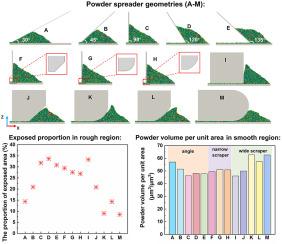Influence of spreader geometries on powder bed quality with rough substrate surfaces in laser powder bed fusion process
IF 4.3
2区 材料科学
Q2 ENGINEERING, CHEMICAL
引用次数: 0
Abstract
The quality of parts manufactured by laser powder bed fusion is closely related to the uniformity and density of the powder bed. In this work, the discrete element method is used to simulate the powder spreading process by different spreader geometries with rough substrate surfaces. The results indicate that reducing the spreader inclination angle significantly increases the number of force chains, enhances compaction, and consequently improves the quality of the powder bed. Studies also show that optimizing the bottom structure of the spreader can effectively reduce exposed areas. An arc-shaped structure promotes particle packing and filling, improving the powder distribution characteristics. A narrow spreader significantly affects the packing density of the powder bed at low layer gaps, whereas a wide spreader is relatively less constrained. At high spreading speeds, the spreader with an inclination angle of 135° produces the highest quality of the powder bed. R1000 performs excellently at larger layer gaps. The above findings provide valuable guidance for optimizing powder spreading strategies in the laser powder bed fusion process.

激光粉末床熔合过程中基材表面粗糙的扩散器几何形状对粉末床质量的影响
激光粉末床熔合加工的零件质量与粉末床的均匀性和密度密切相关。本文采用离散元法模拟了在粗糙基底表面下,不同形状的撒粉器的撒粉过程。结果表明,减小撒布机倾角可显著增加力链数量,增强压实力,从而提高粉床质量。研究还表明,优化吊具底部结构可以有效减少暴露面积。弧形结构促进颗粒的堆积和填充,改善粉末的分布特性。在较低的层隙处,较窄的铺布器对粉末床的堆积密度影响较大,而较宽的铺布器受到的约束相对较小。在高散布速度下,135°倾角的散布器产生最高质量的粉床。R1000在较大的层隙下表现优异。上述研究结果对优化激光粉末床熔敷过程中的粉末扩散策略具有重要的指导意义。
本文章由计算机程序翻译,如有差异,请以英文原文为准。
求助全文
约1分钟内获得全文
求助全文
来源期刊

Particuology
工程技术-材料科学:综合
CiteScore
6.70
自引率
2.90%
发文量
1730
审稿时长
32 days
期刊介绍:
The word ‘particuology’ was coined to parallel the discipline for the science and technology of particles.
Particuology is an interdisciplinary journal that publishes frontier research articles and critical reviews on the discovery, formulation and engineering of particulate materials, processes and systems. It especially welcomes contributions utilising advanced theoretical, modelling and measurement methods to enable the discovery and creation of new particulate materials, and the manufacturing of functional particulate-based products, such as sensors.
Papers are handled by Thematic Editors who oversee contributions from specific subject fields. These fields are classified into: Particle Synthesis and Modification; Particle Characterization and Measurement; Granular Systems and Bulk Solids Technology; Fluidization and Particle-Fluid Systems; Aerosols; and Applications of Particle Technology.
Key topics concerning the creation and processing of particulates include:
-Modelling and simulation of particle formation, collective behaviour of particles and systems for particle production over a broad spectrum of length scales
-Mining of experimental data for particle synthesis and surface properties to facilitate the creation of new materials and processes
-Particle design and preparation including controlled response and sensing functionalities in formation, delivery systems and biological systems, etc.
-Experimental and computational methods for visualization and analysis of particulate system.
These topics are broadly relevant to the production of materials, pharmaceuticals and food, and to the conversion of energy resources to fuels and protection of the environment.
 求助内容:
求助内容: 应助结果提醒方式:
应助结果提醒方式:


